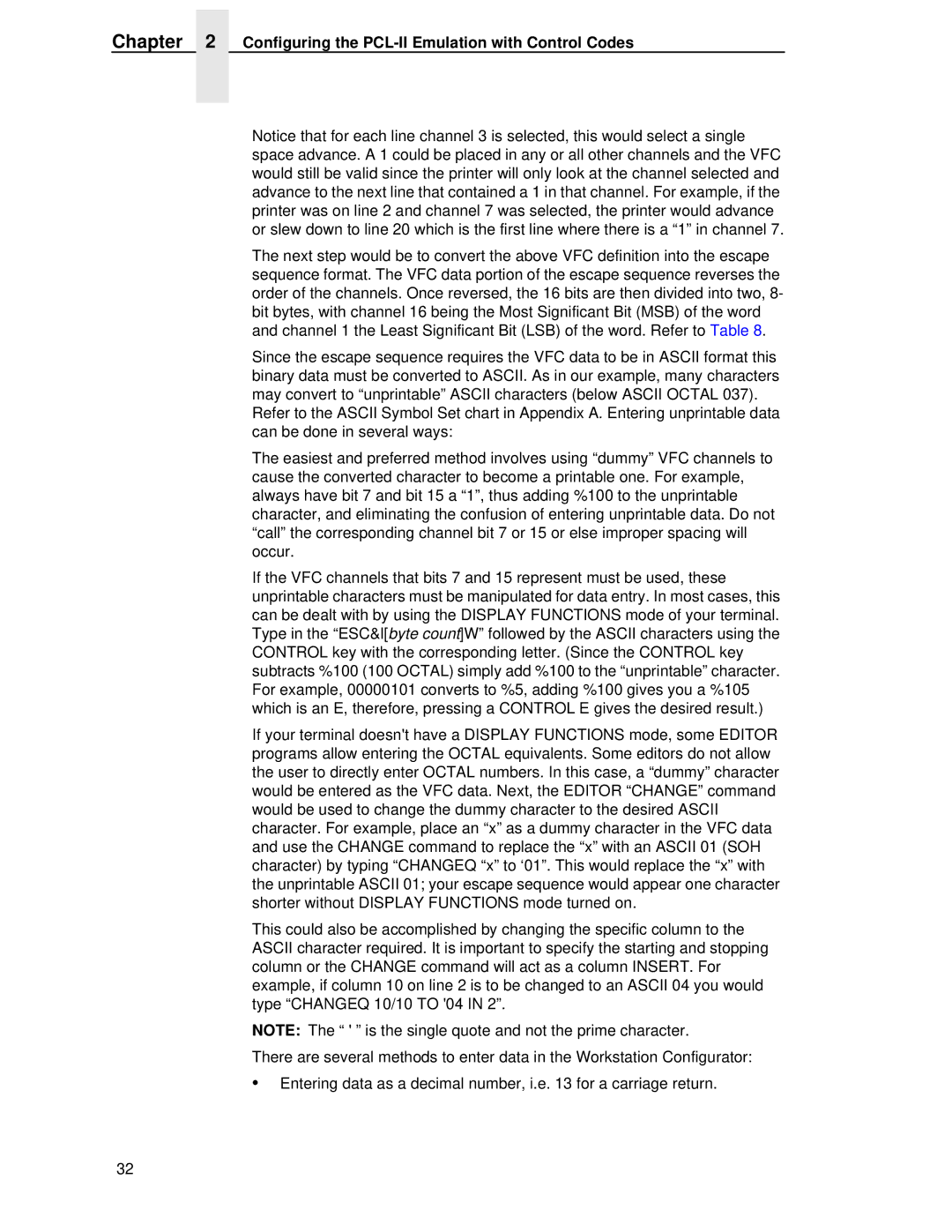
Chapter 2 Configuring the PCL-II Emulation with Control Codes
Notice that for each line channel 3 is selected, this would select a single space advance. A 1 could be placed in any or all other channels and the VFC would still be valid since the printer will only look at the channel selected and advance to the next line that contained a 1 in that channel. For example, if the printer was on line 2 and channel 7 was selected, the printer would advance or slew down to line 20 which is the first line where there is a “1” in channel 7.
The next step would be to convert the above VFC definition into the escape sequence format. The VFC data portion of the escape sequence reverses the order of the channels. Once reversed, the 16 bits are then divided into two, 8- bit bytes, with channel 16 being the Most Significant Bit (MSB) of the word and channel 1 the Least Significant Bit (LSB) of the word. Refer to Table 8.
Since the escape sequence requires the VFC data to be in ASCII format this binary data must be converted to ASCII. As in our example, many characters may convert to “unprintable” ASCII characters (below ASCII OCTAL 037).
Refer to the ASCII Symbol Set chart in Appendix A. Entering unprintable data can be done in several ways:
The easiest and preferred method involves using “dummy” VFC channels to cause the converted character to become a printable one. For example, always have bit 7 and bit 15 a “1”, thus adding %100 to the unprintable character, and eliminating the confusion of entering unprintable data. Do not “call” the corresponding channel bit 7 or 15 or else improper spacing will occur.
If the VFC channels that bits 7 and 15 represent must be used, these unprintable characters must be manipulated for data entry. In most cases, this can be dealt with by using the DISPLAY FUNCTIONS mode of your terminal. Type in the “ESC&l[byte count]W” followed by the ASCII characters using the CONTROL key with the corresponding letter. (Since the CONTROL key subtracts %100 (100 OCTAL) simply add %100 to the “unprintable” character. For example, 00000101 converts to %5, adding %100 gives you a %105 which is an E, therefore, pressing a CONTROL E gives the desired result.)
If your terminal doesn't have a DISPLAY FUNCTIONS mode, some EDITOR programs allow entering the OCTAL equivalents. Some editors do not allow the user to directly enter OCTAL numbers. In this case, a “dummy” character would be entered as the VFC data. Next, the EDITOR “CHANGE” command would be used to change the dummy character to the desired ASCII character. For example, place an “x” as a dummy character in the VFC data and use the CHANGE command to replace the “x” with an ASCII 01 (SOH character) by typing “CHANGEQ “x” to ‘01”. This would replace the “x” with the unprintable ASCII 01; your escape sequence would appear one character shorter without DISPLAY FUNCTIONS mode turned on.
This could also be accomplished by changing the specific column to the ASCII character required. It is important to specify the starting and stopping column or the CHANGE command will act as a column INSERT. For example, if column 10 on line 2 is to be changed to an ASCII 04 you would type “CHANGEQ 10/10 TO '04 IN 2”.
NOTE: The “ ' ” is the single quote and not the prime character.
There are several methods to enter data in the Workstation Configurator:
•Entering data as a decimal number, i.e. 13 for a carriage return.
32
